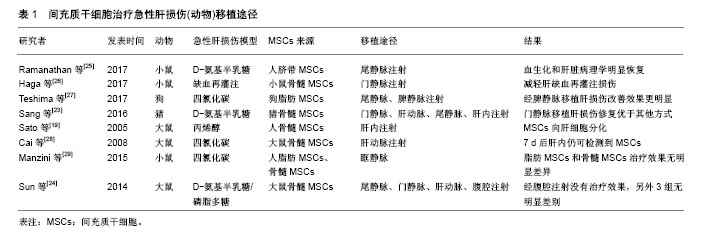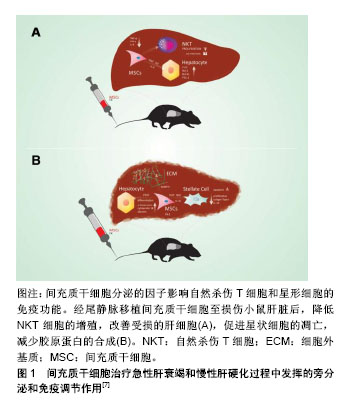| [1] Krawitz S, Lingiah V, Pyrsopoulos NT.Acute Liver Failure: Mechanisms of Disease and Multisystemic Involvement.Clin Liver Dis. 2018;22(2):243-256. [2] D'souza N, Rossignoli F, Golinelli G, et al. Mesenchymal stem/stromal cells as a delivery platform in cell and gene therapies.BMC Med. 2015;13:186. [3] Abbasi-Malati Z, Roushandeh AM, Kuwahara Y, et al. Mesenchymal Stem Cells on Horizon: A New Arsenal of Therapeutic Agents.Stem Cell Rev. 2018;14(4):484-499. [4] Tan CY, Lai RC, Wong W, et al. Mesenchymal stem cell-derived exosomes promote hepatic regeneration in drug-induced liver injury models.Stem Cell Res Ther. 2014;5(3):76. [5] Wang Y, Yu X, Chen E, et al. Liver-derived human mesenchymal stem cells: a novel therapeutic source for liver diseases.Stem Cell Res Ther. 2016;7(1):71. [6] 李培杰,王佳,李伟之,等.人脐血间充质干细胞在大鼠急性肝损伤修复中的作用[J].陕西医学杂志,2017,46(6):702-705.[7] Volarevic V, Nurkovic J, Arsenijevic N, et al. Concise review: Therapeutic potential of mesenchymal stem cells for the treatment of acute liver failure and cirrhosis.Stem Cells. 2014; 32(11):2818-2823. [8] Friedenstein AJ, Petrakova KV, Kurolesova AI, et al. Heterotopic of bone marrow. Analysis of precursor cells for osteogenic and hematopoietic tissues.Transplantation. 1968; 6(2):230-247. [9] Friedenstein AJ, Gorskaja JF, Kulagina NN.Fibroblast precursors in normal and irradiated mouse hematopoietic organs.Exp Hematol. 1976;4(5):267-274. [10] Caplan AI.Mesenchymal stem cells.J Orthop Res. 1991; 9(5): 641-650. [11] Zhao L, Chen S, Shi X, et al. A pooled analysis of mesenchymal stem cell-based therapy for liver disease.Stem Cell Res Ther. 2018;9(1):72. [12] Vizoso FJ, Eiro N, Cid S, et al. Mesenchymal Stem Cell Secretome: Toward Cell-Free Therapeutic Strategies in Regenerative Medicine.Int J Mol Sci. 2017;18(9):E1852. [13] Kang ES, Kim DS, Suhito IR, et al. Two-dimensional material-based bionano platforms to control mesenchymal stem cell differentiation.Biomater Res. 2018;22:10. [14] Roushandeh AM, Bahadori M, Roudkenar MH.Mesenchymal Stem Cell-based Therapy as a New Horizon for Kidney Injuries.Arch Med Res. 2017;48(2):133-146. [15] Liepelt A, Tacke F.Stromal cell-derived factor-1 (SDF-1) as a target in liver diseases.Am J Physiol Gastrointest Liver Physiol. 2016;311(2):G203-209. [16] Lukáš Z, Ba?enkováD, Soltys J, et al. Bioactive mediators Associated with Mesenchymal Stem Cells -Mediated Immunomodulation.J J Bone Stem Res. 2005;1(2):006. [17] Wang M, Yuan Q, Xie L.Mesenchymal Stem Cell-Based Immunomodulation: Properties and Clinical Application.Stem Cells Int. 2018;2018:3057624. [18] Di Bonzo LV, Ferrero I, Cravanzola C, et al. Human mesenchymal stem cells as a two-edged sword in hepatic regenerative medicine: engraftment and hepatocyte differentiation versus profibrogenic potential.Gut. 2008;57(2): 223-231. [19] Sato Y, Araki H, Kato J, et al. Human mesenchymal stem cells xenografted directly to rat liver are differentiated into human hepatocytes without fusion.Blood. 2005;106(2): 756-763. [20] Popp FC, Slowik P, Eggenhofer E, et al. No contribution of multipotent mesenchymal stromal cells to liver regeneration in a rat model of prolonged hepatic injury.Stem Cells.2007; 25(3): 639-645. [21] Deng L, Kong X, Liu G, et al. Transplantation of Adipose-Derived Mesenchymal Stem Cells Efficiently Rescues Thioacetamide-Induced Acute Liver Failure in Mice. Transplant Proc. 2016;48(6):2208-2215. [22] Zhao X, Shi XL, Zhang ZH, et al. Role of neutrophils in treatment of rats with D-galactosamine-induced acute liver failure with bone marrow mesenchymal stem cells.Zhonghua Gan Zang Bing Za Zhi. 2016;24(8):601-607. [23] Sang JF, Shi XL, Han B, et al. Intraportal mesenchymal stem cell transplantation prevents acute liver failure through promoting cell proliferation and inhibiting apoptosis. Hepatobiliary Pancreat Dis Int. 2016;15(6):602-611. [24] Sun L, Fan X, Zhang L, et al. Bone mesenchymal stem cell transplantation via four routes for the treatment of acute liver failure in rats.Int J Mol Med. 2014;34(4):987-996. [25] Ramanathan R, Rupert S, Selvaraj S, et al. Role of Human Wharton's Jelly Derived Mesenchymal Stem Cells (WJ-MSCs) for Rescue of d-Galactosamine Induced Acute Liver Injury in Mice.J Clin Exp Hepatol. 2017;7(3):205-214. [26] Haga H, Yan IK, Borrelli DA, et al. Extracellular vesicles from bone marrow-derived mesenchymal stem cells protect against murine hepatic ischemia/reperfusion injury.Liver Transpl. 2017;23(6):791-803. [27] Teshima T, Matsumoto H, Michishita M, et al. Allogenic Adipose Tissue-Derived Mesenchymal Stem Cells Ameliorate Acute Hepatic Injury in Dogs.Stem Cells Int. 2017;2017:3892514. [28] Cai J, Zhang X, Wang X, et al. In vivo MR imaging of magnetically labeled mesenchymal stem cells transplanted into rat liver through hepatic arterial injection.Contrast Media Mol Imaging. 2008;3(2):61-66. [29] Manzini BM, da Silva Santos Duarte A, Sankaramanivel S, et al. Useful properties of undifferentiated mesenchymal stromal cells and adipose tissue as the source in liver-regenerative therapy studied in an animal model of severe acute fulminant hepatitis.Cytotherapy. 2015;17(8):1052-1065. [30] Manzini BM, da Silva Santos Duarte A, Sankaramanivel S, et al. Useful properties of undifferentiated mesenchymal stromal cells and adipose tissue as the source in liver-regenerative therapy studied in an animal model of severe acute fulminant hepatitis.Cytotherapy. 2015;17(8):1052-1065. [31] Song HL, Shen ZY, Zheng WP, et al. Differentiation of bone marrow-derived mesenchymal stem cells into hepatocyte-like cells and their regulatory effects on activated lymphocytes and liver graft regeneration and rejection. J Hepatology. 2015;62(1):S295. [32] Lange C, Bassler P, Lioznov MV, et al. Liver-specific gene expression in mesenchymal stem cells is induced by liver cells.World J Gastroenterol. 2005;11(29):4497-4504. [33] Luk JM, Wang PP, Lee CK, et al. Hepatic potential of bone marrow stromal cells: Development of in vitro co-culture and intra-portal transplantation models. J Immunol Methods. 2005; 305(1):39-47. [34] Zheng YB, Gao ZL, Xie C, et al. Characterization and hepatogenic differentiation of mesenchymal stem cells from human amniotic fluid and human bone marrow: a comparative study.Cell Biol Int. 2008;32(11):1439-1448. [35] Sato Y, Araki H, Kato J, et al. Human mesenchymal stem cells xenografted directly to rat liver are differentiated into human hepatocytes without fusion.Blood. 2005;106(2):756-763. [36] Camargo FD, Finegold M, Goodell MA.Hematopoietic myelomonocytic cells are the major source of hepatocyte fusion partners.J Clin Invest. 2004;113(9):1266-1270. [37] Liu WH, Song FQ, Ren LN, et al. The multiple functional roles of mesenchymal stem cells in participating in treating liver diseases.J Cell Mol Med. 2015;19(3):511-520. [38] Aggarwal S, Pittenger MF.Human mesenchymal stem cells modulate allogeneic immune cell responses.Blood. 2005; 105(4):1815-1822. [39] Simovic Markovic B, Nikolic A, Gazdic M, et al. Pharmacological Inhibition of Gal-3 in Mesenchymal Stem Cells Enhances Their Capacity to Promote Alternative Activation of Macrophages in Dextran Sulphate Sodium-Induced Colitis.Stem Cells Int. 2016;2016:2640746. [40] Milosavljevic N, Gazdic M, Simovic Markovic B, et al. Mesenchymal stem cells attenuate acute liver injury by altering ratio between interleukin 17 producing and regulatory natural killer T cells.Liver Transpl. 2017;23(8):1040-1050. [41] Moll G, Alm JJ, Davies LC, et al. Do cryopreserved mesenchymal stromal cells display impaired immunomodulatory and therapeutic properties. Stem Cells. 2014;32(9):2430-2442. [42] Lotfinia M, Kadivar M, Piryaei A, et al. Effect of Secreted Molecules of Human Embryonic Stem Cell-Derived Mesenchymal Stem Cells on Acute Hepatic Failure Model. Stem Cells Dev. 2016;25(24):1898-1908. [43] Ma HC, Shi XL, Ren HZ, et al. Targeted migration of mesenchymal stem cells modified with CXCR4 to acute failing liver improves liver regeneration.World J Gastroenterol. 2014; 20(40):14884-14894. [44] Heymann F, Hamesch K, Weiskirchen R, et al. The concanavalin A model of acute hepatitis in mice.Lab Anim. 2015;49(1 Suppl):12-20. [45] Wang H, Zhao T, Xu F, et al. How important is differentiation in the therapeutic effect of mesenchymal stromal cells in liver disease. Cytotherapy. 2014;16(3):309-318. [46] Dhawan A, Puppi J, Hughes RD, et al. Human hepatocyte transplantation: current experience and future challenges.Nat Rev Gastroenterol Hepatol. 2010;7(5):288-298. [47] Sun K, Xie X, Xie J, et al. Cell-based therapy for acute and chronic liver failures: distinct diseases, different choices.Sci Rep. 2014;4:6494. [48] Amiri F, Molaei S, Bahadori M, et al. Autophagy-Modulated Human Bone Marrow-Derived Mesenchymal Stem Cells Accelerate Liver Restoration in Mouse Models of Acute Liver Failure. Iran Biomed J. 2016;20(3):135-144. [49] Xu LJ, Wang SF, Wang DQ, et al. Adipose-derived stromal cells resemble bone marrow stromal cells in hepatocyte differentiation potential in vitro and in vivo.World J Gastroenterol. 2017;23(38):6973-6982.[50] Zhu X, He B, Zhou X, et al. Effects of transplanted bone-marrow-derived mesenchymal stem cells in animal models of acute hepatitis.Cell Tissue Res. 2013;351(3): 477-486. [51] Zhang Y, Yang P, Sun T, et al. miR-126 and miR-126* repress recruitment of mesenchymal stem cells and inflammatory monocytes to inhibit breast cancer metastasis.Nat Cell Biol. 2013;15(3):284-294. [52] Li GC, Zhang HW, Zhao QC, et al. Mesenchymal stem cells promote tumor angiogenesis via the action of transforming growth factor β1.Oncol Lett. 2016;11(2):1089-1094. [53] Mi F, Gong L.Secretion of interleukin-6 by bone marrow mesenchymal stem cells promotes metastasis in hepatocellular carcinoma.Biosci Rep. 2017;37(4): BSR20170181. [54] Lacina L, Plzak J, Kodet O, et al. Cancer Microenvironment: What Can We Learn from the Stem Cell Niche.Int J Mol Sci. 2015;16(10):24094-24110. [55] Park JS, Suryaprakash S, Lao YH, et al. Engineering mesenchymal stem cells for regenerative medicine and drug delivery. Methods. 2015;84:3-16. [56] Alfaifi M, Eom YW, Newsome PN, et al. Mesenchymal stromal cell therapy for liver diseases.J Hepatol. 2018;68(6):1272- 1285. [57] Tsolaki E, Yannaki E.Stem cell-based regenerative opportunities for the liver: State of the art and beyond.World J Gastroenterol. 2015;21(43):12334-12350. [58] Cheng L, Zhang K, Wu S, et al. Focus on Mesenchymal Stem Cell-Derived Exosomes: Opportunities and Challenges in Cell-Free Therapy.Stem Cells Int. 2017;2017:6305295. [59] Visweswaran M, Pohl S, Arfuso F, et al. Multi-lineage differentiation of mesenchymal stem cells - To Wnt, or not Wnt.Int J Biochem Cell Biol. 2015;68:139-147. [60] Sawitza I, Kordes C, Götze S, et al. Bile acids induce hepatic differentiation of mesenchymal stem cells.Sci Rep. 2015; 5: 13320. [61] Heo J, Ahn EK, Jeong HG, et al. Transcriptional characterization of Wnt pathway during sequential hepatic differentiation of human embryonic stem cells and adipose tissue-derived stem cells.Biochem Biophys Res Commun. 2013;434(2):235-240. |
.jpg)



.jpg)